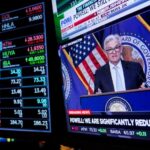By Panos Mourdoukoutas
The Dow Jones Industrial Average ended last week at a record for the year, and small caps rallied as Fed Chair Jerome Powell paved the way for interest rate cuts in his Jackson Hole speech on Friday.
Meanwhile, mixed corporate and economic headlines and valuation concerns throughout the week tamed the gains for the broader market. At the same time, tech shares failed to regain the ground they lost in the previous trading sessions.
The S&P 500 finished the week ending Aug. 22 at 6,466.91, up by 0.27 percent for the week and slightly below another record it reached on Aug. 14.
The Dow gained 1.53 percent to end at 45,631.74, the first record for the year.
The technology-heavy Nasdaq lost 0.58 percent to 21,496.54, while the Russell 2000 fared the best, rallying by 3.30 percent on top of the 3.07 percent it gained in the previous week.
Market volatility, as measured by the Chicago Board Options Exchange Volatility Index, declined sharply following the Fed chair’s speech, indicating a growing complacency among equity market participants.
After flirting with record highs last week, U.S. stocks opened for trade on Aug. 18 lower, led by weakness in European markets, and anxiety over upcoming earnings from the nation’s large retailers.
Adding to the selling pressure were concerns over stretched market valuations among AI-tech related shares trading at a high Price-to-Earnings (PE) ratio.
Still, all major equity indexes ended the trading day almost unchanged, which turned out to be the calm before the storm for the tech sector.
Selling pressure in high PE stocks accelerated on Tuesday morning, with Palantir, Oracle, and AMD shares posting sizable losses.
The selling persisted throughout the day, but the major indexes ended mixed thanks to gains in Home Depot, which gave an upbeat earnings guidance for the rest of the year, and market rotation from the high-PE to low-PE sectors.
Valuation concerns continued to pressure the market on Wednesday morning, aided by two weak earnings reports—one from Target and another from Estée Lauder—raising doubts about the resilience of earnings and consumer spending, a critical driver of the market in recent months.
“Stock market valuations are full right now, leaving little wiggle room for disappointment,” Carol Schleif, chief market strategist at BMO Private Wealth in Minneapolis, told The Epoch Times. “The stock market is currently discounting a bright future ahead. That assessment is largely justified thanks to earnings, which have been much stronger than initially expected and increasing clarity on trade and tax policy. Companies, consumers, and the economy in general have displayed a great deal more resilience than many had projected.”
However, once again, sector rotation moderated the losses, helping the market trade sideways, a pattern that extended on Thursday’s trade, amid mixed corporate and economic headlines.
On the corporate front, Boeing rose on news of sales of 500 planes to China, while Walmart lost ground as it missed earnings expectations due to insurance claims, legal costs, and restructuring changes.
On the economic front, initial jobless claims jumped by 11,000 from the previous week to 235,000 on the second week of August, ahead of market expectations.
It was the second sharpest one-week count in eight weeks, reigniting talk among experts over the weakening of the labor market and its implications for monetary policy.
“While this week’s jobless claims report is unlikely to sway the Fed—and it shouldn’t—the overall deceleration in the labor market has quickly put into question just how strong the jobs market really is. Given how critical consumer spending is to the U.S. economy, markets and investors alike do not want to see further weakness when it comes to U.S. jobs,” eToro U.S. investment analyst Bret Kenwell told The Epoch Times.
Meanwhile, the S&P Global U.S. Manufacturing PMI rose to 53.3 in August 2025 from 49.8 in July, beating market expectations of 49.5, indicating an improvement in manufacturing conditions, making any talk of a Fed sway premature.
The situation changed dramatically on Friday morning when the Fed chair, in his very much anticipated Jackson Hole speech, delivered what markets wanted to hear: a shifting of the balance of risks requires policy adjustment, paving the way for interest rate cuts.
Heather Long, chief economist at Navy Federal Credit Union, said Powell “clearly opened the door to a September rate cut.”
“He justifies this change in view by acknowledging the downside risks to employment after the shocking July jobs report,” she told the Epoch Times.
Paul Stanley, chief investment officer at Granite Bay Wealth Management, concurred that a September rate cut is on the table.
“Whether it will be 25 basis points or 50 basis points is still unknown, but the idea that the Fed is open to cutting rates is bullish for stocks. Investors have been worried in recent months about the sudden and sharp slowdown in hiring, and lower rates would help to ease financial conditions and potentially give employers more confidence to expand and hire,” Stanley said.
The prospect of interest rate cuts gave investors plenty of confidence in buying shares across the board, helping the Dow reach its first record for the year, and interest rate-sensitive small caps continue their relentless rally, gaining more than 6 percent in the last two weeks.
Still, Stanley is somewhat cautious due to market valuations. “The stock market is priced for perfection right now, and we would not be surprised to see the historical September weakness come about over the coming weeks,” he said.
“While September is usually a negative month for stocks, the final months of the year are also seasonally positive, making any September weakness a buying opportunity.”





